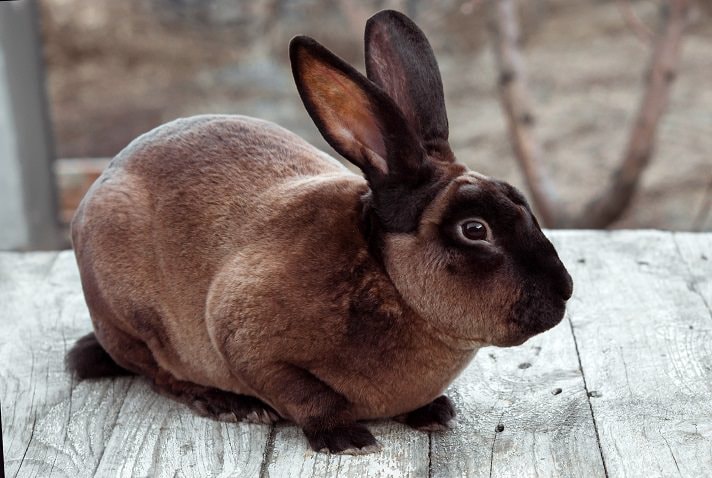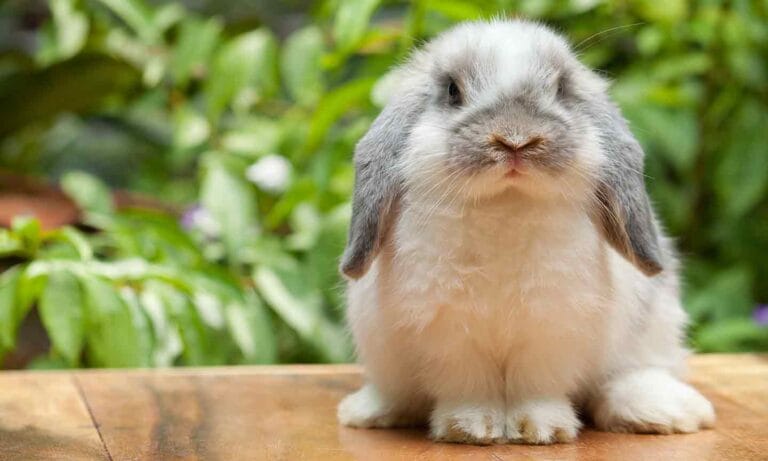The American Rabbit Breeders Association (ARBA) recognizes 48 different purebred rabbit breeds. Some of the breeds–like the critically endangered American, American Chinchilla and Silver Fox rabbits–are quite rare, while some of the other breeds–like the Netherland Dwarf and Holland Lop–are hugely popular.
Of course, only one of the 48 breeds has the distinction of being the most popular rabbit breed, and that is none other than the marvelous, the magnificent, the majestic Mini Rex. In the five-year period between 2005 and 2009, there were 93,853 rabbits shown at the annual conventions of the ARBA. Of these entries, more than 12,000 of them were Mini Rex, an astonishing 12.8 percent of all rabbits shown. This is even more astonishing when you consider that if you swing back the clock a mere 30 years, the Mini Rex breed didn’t even exist. What is it about the Mini Rex that has made the breed so incredibly popular? And how did the breed make such impressive strides in this relatively short period of time?
The Marvelous Mini Rex
Perhaps you’re familiar with the Rex breed–large, velvet-coated rabbits that have enjoyed popularity since their development in the early part of the 20th century. Rex rabbits generally weigh in between 8 and 10 pounds, and they are well-loved for their incredibly soft Rex coats. Yet in recent years, the popularity of the smaller breeds has been rapidly increasing. Thanks to the existence of Mini Rex, Rex fanciers have been able to enjoy all of the characteristics that they admired in the Rex breed, wrapped up in an extra-special, small-sized package.
As you may have guessed by their name, Mini Rex rabbits are not large; they generally hop–er, make that top–the scales at somewhere between 3 and 4.5 pounds. For many people, this size makes the Mini Rex an ideal choice for a family pet.
“They are a perfect size for children to handle which makes them a favorite among my 4-H members,” said Dori Smith of Rose Arbor Rabbitry in Michigan, who has raised Mini Rex rabbits for more than 10 years. “Their quiet personalities make them a rabbit that is generally easy to handle.”
Aside from their superlative size, the Mini Rex breed also boasts a prominent characteristic that sets this rabbit apart from almost every other breed recognized by the ARBA, and that characteristic is the peerlessly plush Rex coat. Only the breed’s larger cousin, the Rex, shares this distinctive coat type, and it truly is one of the trademark features of the Rex breeds.
The Rex coat is smooth and velvetlike; ideally 5/8 of an inch in length and extremely dense, with a softness that is simply unrivaled. “The first time you touch a Mini Rex there is no mistaking their coats,” said Dae Williams, president of the National Mini Rex Rabbit Club. “They are one of the most plush, resilient coats you have ever laid your hands on. Like most of us,” he added, “you’ll be hooked.”
Similar sentiments are expressed by Smith. “Mini Rex are undeniably one of the softest, cutest, small bunnies available, which accounts for their popularity. There is something wonderful that happens when we stroke that soft, plush fur and take in that cute little expression. It’s bunny therapy!”
Another winning aspect of the Mini Rex is the breed’s appealingly sweet disposition, which further cements this rabbit’s excellence as a family pet. “The breed has a very even temperament,” Williams said. “Most pet owners enjoy petting their animals, but few pets enjoy a gentle rubbing of the forehead more than a Mini Rex. Immediately, a Mini Rex will close its eyes.”
Smith has found that, compared to some of the other rabbit breeds, Mini Rex rabbits seem to be calmer when being handled. “Most Mini Rex enjoy the attention of their owner and will eagerly come to the front of their cage to have their face and ears gently rubbed,” she adds.
So when you combine their endearing personalities, their superbly soft coats, and their appealing size, it’s easy to see why the Mini Rex has achieved such heights of popularity. But just 30 short years ago there was no such thing as a Mini Rex–so where did the breed come from?
The Mini Rex In History
The Mini Rex breed got started through the vision of rabbit enthusiast Monna Berryhill. In 1984, she bred “Zoro, an imported Dwarf Rex buck, with an undersized Lynx Rex doe named Cotton.” In November of that year, the very first litter of Mini Rex arrived, consisting of seven kits. According to Berryhill, the seven kits were all uniform in every way except color–there were Blues, Blacks and one Opal.
As she watched them grow, Berryhill felt rising excitement. “The dream was born in the back of my mind that it just might be possible I had stumbled on a new and exciting breed,” she recalled. “I kept the Opal doe, and shipped a Black doe and Blue doe to some very interested ladies in Sarasota, Fla. The Mini Rex was born!” Berryhill continued to breed her Mini Rex with the goal of official ARBA recognition in mind.
In 1985, Berryhill took a few of her newly developed Mini Rex rabbits to the ARBA convention “just to see if they might generate any interest,” and then made her first presentation of the breed to the ARBA standards committee at the 1986 convention. By the time the 1987 convention rolled around, enthusiasm was growing for the up-and-coming breed and more than 100 Mini Rex were entered. (Berryhill made her second presentation to the ARBA standards committee at that time.)
The third presentation of the Mini Rex breed was at the 1988 convention in Madison, Wisconsin, and at that time the ARBA officially recognized the Mini Rex breed as a breed. “There was tremendous celebration,” Berryhill said. “Their popularity literally exploded all across the country. I had no idea of the upheaval that first litter would create. Today, Mini Rex are being bred and raised in England, Hungary, Norway, Sweden, Denmark and Finland … I am literally speechless at their popularity!”
The Mini Rex Today
As previously discussed, the Mini Rex breed has had an incredible impact on the national show scene. The Mini Rex is the breed most commonly shown by adults, and also the most popular breed shown by youth exhibitors. Stop by any ARBA-sanctioned rabbit show—or any county fair, for that matter—and you’re likely to find a beautiful array of Mini Rex rabbits on display.
In recent years, the rarer rabbit breeds have tended to receive a lot of attention due to their need for preservation, but there are also innumerable benefits to owning or showing a popular breed like the Mini Rex.
For those who enjoy the thrill of competitive showing, there’s never a lack of strong competition when showing Mini Rex. Another benefit is the ability to experience the camaraderie of an enthusiastic group of individuals who share your affection for a particular breed of rabbit.
“It is easy to find others who share your love of this breed,” Smith said. “There is lots of opportunity to compete with your Mini Rex if that is your interest, or perhaps you may just enjoy socializing with a large online community of fanciers. The ARBA and the NMRRC both sponsor many types of youth activities that are very popular. The annual national convention and shows are a fun get-together where we make friends with kids and adults from all over the United States and occasionally overseas.”
The Mini Rex At Home
While the Mini Rex has undoubtedly achieved unparalleled success as a show rabbit, the breed also takes top prize as a pet rabbit, thanks to their universally appealing characteristics. While there are always individual exceptions to the rule, the majority of Mini Rex rabbits are calm, pleasant, and sensible, while not devoid of personality. Mini Rex are always happy to have attention, making them delightful companions and pets.
“Their pleasant personalities and small size make them the ideal candidate for a house pet,” Berryhill said, and she nots that rabbits can be trained to use the litter box.
Smith seconded the suggestion that a Mini Rex is a suitable candidate for joining the family lifestyle. “The small size of the Mini Rex is perfect for an indoor pet,” she said. “The short, velvetlike coat is easy to care for and they require very little grooming.”
In addition to the overall softness of the Mini Rex coat and their relative ease of care, individuals with allergies may find the short coat appealing for yet another reason. “The Mini Rex is also one of the most hypoallergenic pets you can purchase,” Williams said. “Although they do shed their coats–fur–they produce less dander than many other pets.”
For many people, the Mini Rex rabbit epitomizes all of the excellent qualities that are sought in a family-friendly rabbit breed. If you like the idea of a velvet-coated rabbit with a pleasant disposition that can be found in a charming and attractive 4-pound package, then you really need look no further than the marvelous, the magnificent, and the majestic Mini Rex.
Monna Berryhill probably sums up the breed best: “They are sweet tempered [and] small in size, making them easier for youngsters and ladies to handle them. They are excellent mothers as well. Then there’s the fur—it is simply exquisite! Anyone who touches one wants one.”
A Rainbow Of Mini Rex
The fun of Mini Rex rabbits is embellished by yet another popular characteristic: The Mini Rex’s extra-special fur can be found in an entire spectrum of colors. Smith believes that the large number of ARBA-recognized Mini Rex colors contributes to the breed’s overall desirability. Of the colors, she said, “There is something that will appeal to any rabbit lover!” And Smith is undoubtedly correct—with well over a dozen recognized varieties, there’s definitely a color (or two!) that will suit the fancy of any rabbit enthusiast.
Currently recognized varieties include Black, Blue, Blue-Eyed White, Broken, Castor, Chinchilla, Chocolate, Himalayan, Lilac, Lynx, Opal, Otter, Red, Sable Point, Seal, Silver Marten, Smoke Pearl, Tortoise and Ruby-Eyed White. Additional colors, including Sable and Tan, are currently in the developmental stage and are hopefully on their way to official approval and recognition by the ARBA.
Out of all of the recognized varieties, the Broken variety is far and away the most popular for showing. Exhibits of Broken-patterned Mini Rex outnumber the second-most popular color (Castor) by nearly 2 to 1. (Black and Ruby-Eyed White are also quite common). Time will tell whether the newer varieties, such as the newly recognized Silver Marten or Smoke Pearl, will achieve the level of popularity reached by the more traditional colors.
Join The Club
Joining a local, state or national rabbit club is a wonderful way to learn more about the Mini Rex breed, so if you’d like to explore the breed on a deeper level, be sure to explore the rabbit clubs in your area, or join the National Mini Rex Rabbit Club (NMRRC), which boasts more than 1,000 members across the United States.
“When joining the NMRRC, you become part of a family of Mini Rex enthusiasts who enjoy sharing experiences, showing their rabbits and creating friendships from coast to coast,” Williams said. He believes that owning and showing rabbits helps to instill responsibility and teaches respect for others, while helping to develop a sense of pride in the accomplishment of maintaining the care of rabbits.
“The National Mini Rex Rabbit Club is committed to the development of the Mini Rex breed, to the education of our youth, and to the promotion of proper animal husbandry as it relates to the care of our breed,” Williams said. “Drop by the NMRRC website and discover all the wonderful things that our breed has to offer.”
By: Samantha Johnson
Featured Image: via HolySource/iStock/Thinkstock
Share:









